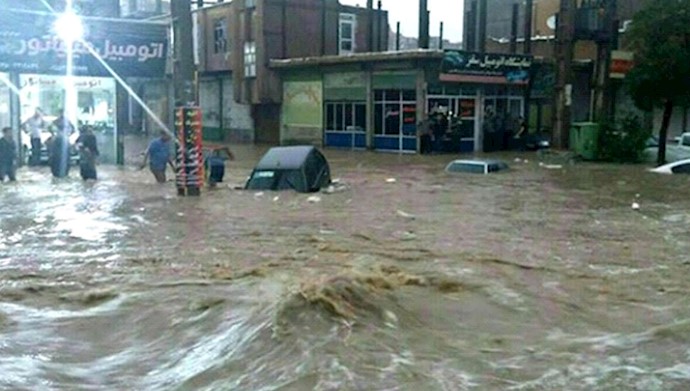Analysis by PMOI/MEK
Feb. 1, 2019 – “The cities of western Iran are mourning, but no one is thinking about us. They’re silent and they’ve abandoned us. No one is thinking about healing our wounds. The flood washed away my land. Earthquakes came in between the floods. Ilam trembled. But again, like previous times, no one said anything. They were silent. Dezful, Andimeshk, Dehloran and Khoram Abad were washed away in the floods. I wish we weren’t so alienated.”
Those were the words of one of the victims of recent floods that struck the western regions of Iran. According to reports, at least 20 provinces have been hit by floods, rainstorms, snowstorms and blizzards. Meanwhile, the government is sitting on its hands.
The villages surrounding Shush, Dezful, Dasht-e Azadegan and Shushtar in Khuzestan province were flooded. At least 18 villages in this region have been besieged by floods. Eight villages have been completely evacuated. Farms and fields have been covered in water. Crops have been destroyed.
In the flood-stricken regions in Khoram Abad, many homes have been filled with water. In Khuzestan, Ilam, Lorestan and Chaharmahal and Bakhtiari Province, the floods have broken several bridges and blocked roads. The threat of the repetition of the 2016 floods that caused severe damages to the are loom darkly.
Floods and droughts, the flip sides of the same coin
Outrageously, while in some regions of Iran, the people are being hit with floods, in others, people are suffering from shortage of potable and irrigation water. In Isfahan, farmers are regularly pouring into the streets to protest against government corruption and mismanagement and to reclaim their natural right to access the province’s water sources. Meanwhile, in Khuzestan, the people of flooded areas are protesting against the lack of public services and poor infrastructures to protect them against natural disasters.
These facts reflect a stark reality. The Iranian regime cares nothing for the safety and livelihoods of the Iranian people. For Iranian regime supreme leader Ali Khamenei and the mullahs who have been ruling in Iran for four decades, the only thing that matter is the preservation of their establishment and power. They’re stealing out of the pockets of the most underprivileged segments of the Iranian society to fill their own coffers and to fund their evil ambitions and goals. They’re arresting, torturing and executing dissidents and protesters to avoid responding to their demands. They’re living lavishly while the lives of the Iranian people continue to spiral down into poverty and misery.
While the people of western Iran were struggling under the pressure of seasonal floods, some of the headlines of state-run media were as follows:
“Unveiling Iran’s newest anti-armor rockets”
“Imam Khamenei pays homage to the graves of the martyrs of engineering operations”
“Latest achievements of the defense ministry enter the production cycle”
“Taliban’s bone in the throat of Kabul”
“Iran’s missile message”
“Assad: We seek partnerships with Iran’s public and private sector to rebuild Syria”
“Assad invites Iranian private companies to rebuild Syria”
“Iran and Syria sign 11 documents for strategic-economic cooperation”
The repeat of 2016 floods
According to reports, in 2016, floods in 20 provinces caused severe damage: The blocking of the water network of 48 villages in Ilam province; the overflowing of several dams, including the Dez dam on the border of Lorestan and Khuzestan provinces and Azadi dam in Kermanshah. The areas surrounding these dams were severely affected, and several people were killed. The third phase of the Abadan oil refinery was shut down by heavy rainfalls. In Ilam, landslides damaged roads in Dehloran. Structures on the shores of rivers were destroyed in Lorestan and Khuzestan.
These are just some of the damages caused by the 2016 flood, and according to expert evaluations, the main cause of such heavy damage was the poorly managed infrastructure of the affected areas. Now, two years later, the western provinces of Iran are threatened by a repeat of the same disaster.
What does this indicate? According to state-run Javan newspaper, “The poor management of officials in fixing flood dams and managing flood waters has exposed several villages and towns in Khuzestan to floods.”
In 2016, the Iranian regime’s own experts stated that had the government allocated enough credit (approx. 40 billion rials) to running programs for protecting the region against floods, they could have avoided the 6-trillion-rial damage the flood caused.
“The floods in western provinces showed that the repeat of these disasters is the result of years of ignoring this issue, and if we don’t have a precise plan, the damages can repeat themselves,” one expert wrote at the time in Iran Online website.
Who’s thinking about the people?
Short answer: certainly not the Iranian regime officials. In the past week, Iranian authorities have only made promises of addressing the problems of the citizens of the areas affected by the floods. But like the past years, the regime has done nothing to solve the most basic problems of the disaster-stricken people. This is very much like the kind of behavior and response the regime has shown to disasters in other areas, including the earthquakes that hit the people of Kermanshah people in the past two years.
Pictures and videos obtained from flooded areas show that the people of the villages of Khuzestan have taken matters into their own hands and are creating flood dams with their bare hands, knowing that regime officials won’t do anything for them. The government’s lack of response has triggered more protests among the people and has added one more reason to the many grievances that have led people across Iran to call for regime change.





